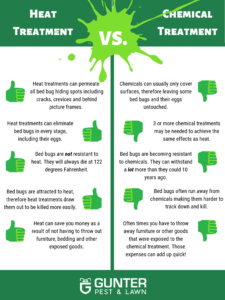Today we will be talking about “Bed Bug Heat Treatment Vs. Chemical Treatments”.
Since 1972 when DDT was banned, there hasn’t been a chemical pesticide with the same ability to kill bed bugs since. Current practices take several treatments with chemicals to disrupt the life cycle of bed bugs. Because there has not been a suitable chemical replacement to DDT, the pest control industry has been forced to find a better way to effectively treat for bed bugs. We are one of the few companies in Kansas City who use the highly effective bed bug heat treatment system.
WHY DOESN’T Gunter USE BED BUG CHEMICAL TREATMENTS?
The reason why we choose to stay away from chemical treatments is that they’re more of a hassle and not as effective for eradicating bed bugs. Chemical treatments only cover the outer surfaces of the room, leaving cracks and crevices (the most popular bed bug hiding places) untouched. Bed bugs are also starting to adapt to chemical treatments…gasp! That’s right, not only will they recognize the scent and run away, but they’re also becoming more resistant to chemicals.
Also, we want to save you money! One of the biggest downsides to chemical treatments is that you’re often forced to throw away all furniture and other home goods that were exposed to the treatment. Replacing all of those items is not cheap and unfortunately, money just doesn’t grow on trees.
The Reason Why We Choose Bed Bug Heat Treatments
The answer is simple—it’s safer and WAY more effective. Heat treatments have the ability to permeate into every possible bed bug hiding spot, even behind picture frames! Unlike chemical treatments, bed bugs are actually drawn to heat (which is also one of the disturbing reasons why they like to cuddle up with humans). The heat treatment draws these nasty bed bugs out and kills them at all stages of life, whether they’re just eggs or full-grown adults.
Many people have reported having to call an exterminator almost immediately after a treatment because the original pest control company didn’t eradicate the eggs. We promise we will never be that company.
Learn About Our Termite Treatment Costs
Last but not least, it saves you time and money! Heat treatments are much easier to conduct since there’s only some spot treatment at the end opposed to the whole process being spot treatment. You can also keep all your furniture! You’ll be able to cross treating your home for bed bugs off your list and not have to add any new tasks to it, therefore everyone wins.
Bed Bug Heat Treatment Vs. Chemical Treatment Infographic

Advantages Of Heat Treatment
- Single Treatment Efficacy: Properly executed heat treatment usually requires only one session, unlike chemical treatments that often need multiple visits.
- Effective Against Hidden Bed Bugs: Bed bugs are resilient and adept at hiding. Some strains are resistant to certain pesticides. Heat permeates all areas, reaching bed bugs no matter how well they’re concealed. It is lethal to bed bugs at all life stages. They can run but they can’t hide from the heat.
- No Residual Chemicals: Once your home cools down, the only change is the absence of bed bugs. This is ideal for those concerned about chemical residues.
- Discreet Process: Heat treatment is inconspicuous. From the street, only a generator is visible, which could be used for various other purposes like running fans, drying paint, or steam cleaning carpets.
Drawbacks Of Heat Treatment
- No Residual Barrier: Heat treatment does not prevent future infestations. Without residual chemicals to provide a barrier, bed bugs may return. Maintaining a clutter-free home and regularly cleaning your bedding are effective non-chemical prevention measures.
- Preparation Required: You will need to vacate your home during treatment, including pets. Heat-sensitive items like wax and crayons should be removed. Pest control experts can advise on what is safe to keep and what should be taken out.
Things to Consider When Using Heat Treatment
Heat treatment is a fast, discreet, and effective method to reach infestation areas that chemicals might miss. However, a prevention strategy is necessary. One effective approach is to combine heat treatment with chemical treatments around the boundaries of your house. This minimizes chemical use inside your home while establishing a residual barrier where it’s most effective.








